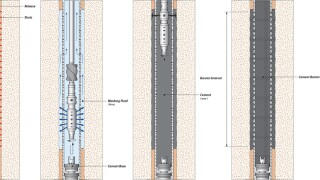Drilling
Oil and gas companies drilled 75 “high-impact” wells in 2024, representing 5.2 billion BOE.
This paper presents a comprehensive literature review of perforate, wash, and cement techniques that compares new methods with traditional ones and uses field cases and computational fluid dynamics to find the most cost- and time-effective practices without sacrificing safety.
The authors of this paper describe a method of stimulating a multizone hydrocarbon-producing well wherein a tool is deployed downhole by wireline to generate acid vapor at a target depth, allowing each interval to be treated uniquely.
-
Rotary-steerable tools (RSTs) are now deemed mainstays in the drilling community.
-
Drillpipe doesn’t last forever, but a Houston-area startup company says it has developed a way to make it last significantly longer.
-
A new rotary-steerable system (RSS) was designed to give geometrically greater dogleg-severity (DLS) capability while still being able to withstand the increased bending stresses.
-
This paper explores the applications, benefits, and value of a high-build-rate rotary-steerable system (HRSS) capable of delivering dogleg severity (DLS) greater than 18°/100 ft.
-
Drillstring vibration is a leading cause of downhole-tool failure and premature wear of downhole equipment.
-
For nanotechnology-based drilling fluids, acceptance means proving they can outperform other drilling fluids. Initial results have been encouraging enough to move toward commercialization.
-
With shrinking budgets and limited resources, partnerships and collaboration are considered the best options. It is no secret that universities and industry have a special platform to work hand-in-hand.
-
Advances made in horizontal and complex-trajectory wells demonstrate that, despite this historic downturn, the industry has kept innovating and optimizing to bring more-efficient solutions to the table.
-
The wireline formation tester (WFT) is a well-developed technology used to collect representative downhole fluid samples. The authors introduce a simple but effective method for monitoring WFT sampling when targeting the low levels of contamination needed for asphaltene-onset-pressure analysis.
-
This work focuses on the laboratory techniques for developing, assessing, and analyzing innovative water-based drilling fluids containing iron oxide (Fe2O3) and silica (SiO2) nanoparticles.













